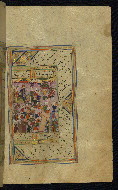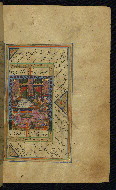Home > Digitized Walters Manuscripts
This document is a tranformation of a TEI P5 XML manuscript description incorporating images. If you have trouble reading special or non-Latin characters on this page, please make sure you have appropriate Unicode fonts installed and an up-to-date web browser.
Walters Ms. W.645, Two poetical works: Yusuf and Zulaykha and Mihr and Mushtari
Browse images (Browse images in a new window) | TEI in XML format
W.645
Two poetical works: Yusuf and Zulaykha and Mihr and Mushtari
Vernacular: يوسف وزليخا
Mihr va MushtarīVernacular: مهر ومشترى
Authority name: Jāmī, 1414-1492
As-written name: Nūr al-Dīn ʿAbd al-Raḥmān ibn Aḥmad Jāmī
Name, in vernacular: نور الدين عبد الرحمان بن احمد جامى
Note: Author dates preferred by cataloger: d. 898 AH / 1492 CE
Authority name: ʻAṣṣār Tabrīzī, Muḥammad, d. 1382 or 3
As-written name: Muḥammad ibn Aḥmad ʿAṣṣār Tabrīzī
Name, in vernacular: محمد بن احمد عصار تبريزى
Note: Author dates preferred by cataloger: d. 784 AH / 1382 CE
This illuminated and illustrated Safavid manuscript, executed in Safavid Iran in the tenth century AH / sixteenth CE, contains two poetical works: Yūsuf va Zulaykhā by Nūr al-Dīn Jāmī (d. 898 AH / 1492 CE) and Mihr va Mushtarī by Muḥammad ibn Aḥmad ‘Aṣṣār Tabrīzī (d. 784 AH / 1382 CE). The two texts can be read side by side on the same page, either written horizontally or obliquely. There are four paintings illustrating the text (fols. 58b, 91a, 159a, and 180b). The brown leather binding with dentelle-style decoration in multi-colored filigree work may date to the tenth century AH / sixteenth CE, although it is unlikely to be original to the manuscript.
10th century AH / 16th CE
Iran
Book
Literary -- Poetry
The primary language in this manuscript is Persian.
Paper
Laid paper
Foliation: i+211
Catchwords: Written obliquely on versos
17.0 cm wide by 27.0 cm high
6.0 cm wide by 10.5 cm high
- Columns: 2
- Ruled lines: 9
- Text inscribed in the main double columns, ending on fol. 207a; framing lines in blue, red, gold, green, and light blue
- Text inscribed in the outer margin of the framed area up to fol. 207a; continues after fol. 207a in both the margin and the double columns; framing lines in blue, red, gold, green, and light blue
- Title: Yūsuf va Zulaykhā
- Author: Jāmī, 1414-1492
- Text note: Beginning lines of the text missing
- Hand note: Written in black nastaʿlīq script with chapter/section headings in white
- Decoration note: Two illustrations; one surviving half of a double-page illuminated frontispiece with information about the works and the incipits (fol.1a); decorated double frame and various geometrically shaped decorated panels within the text; framing lines in blue, red, gold, green, and light blue
- Title: Mihr va Mushtarī
- Author: ʻAṣṣār Tabrīzī, Muḥammad, d. 1382 or 3
- Text note: Beginning lines of the text missing
- Hand note: Written in black nastaʿlīq script with chapter/section headings in white
- Decoration note: Two illustrations; one surviving half of a double-page illuminated frontispiece with information about the works and the incipits (fol.1a); decorated double frame and various geometrically shaped decorated panels within the text; framing lines in blue, red, gold, green, and light blue
fol. 1a:
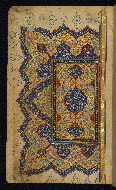
- Title: Double-page illuminated frontispiece
- Form: Frontispiece; incipit
- Label: This is the right side of a double-page illuminated frontispiece. (The left side does not survive.) The initial lines of the texts are inscribed in the central medallion and pendants in white nastaʿlīq script on a blue background.
fol. 58b:
fol. 91a:
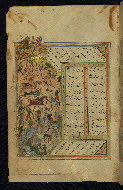
- Title: Mihr and his friends slaughter dog- and wolf-headed cannibals
- Form: Illustration
- Text: Mihr and Mushtari
fol. 159a:
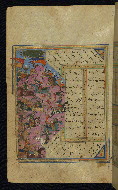
- Title: Qarā Khān, king of Samarqand, defeated by Mihr
- Form: Illustration
- Text: Mihr and Mushtari
- Label: On the left side of this page Qarā Khān, king of Samarqand, is defeated by Mihr, who fights on the side of King Kayvān, Nāhīd’s father.
fol. 180b:
The binding is not original.
May date to the tenth century AH / sixteenth CE; brown leather (no flap); dentelle-style decoration in multi-colored filigree work
Oval seal: ʿAbduhu Muḥammad Kāẓim (fol. 113b)
Square seal: ʿIṣmat Zīnat Sulṭān, dated 12[?]49 AH / 1833 CE (fol. 114a)
Walters Art Museum, 1931, by Henry Walters bequest
Principal cataloger: Gacek, Adam
Catalogers: Landau, Amy; Smith, Sita
Editor: Bockrath, Diane
Conservators: Jewell, Stephanie; Quandt, Abigail
Contributors: Barrera, Christina; Emery, Doug; Herbert, Lynley; Noel, William; Simpson, Shreve; Tabritha, Ariel; Toth, Michael B.; Valle, Chiara
The Walters Art Museum
Licensed for use under Creative Commons Attribution-NonCommercial-ShareAlike 3.0 Unported Access Rights, http://creativecommons.org/licenses/by-nc-sa/3.0/legalcode. It is requested that copies of any published articles based on the information in this data set be sent to the curator of manuscripts, The Walters Art Museum, 600 North Charles Street, Baltimore MD 21201.
